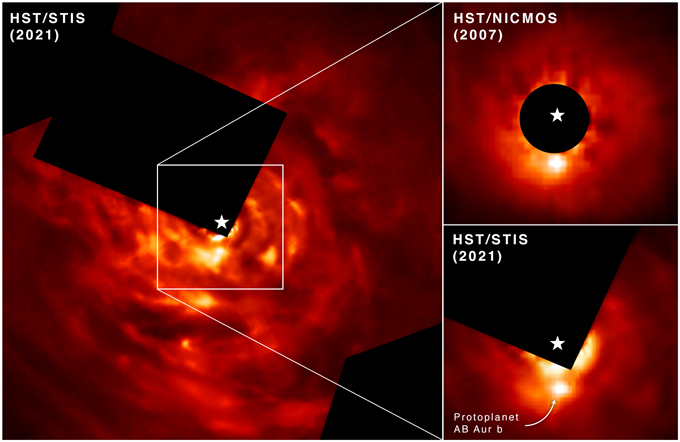A young, massive planet is orbiting in an unusual place in its star system, and it’s leading researchers to revive a long-debated view of how giant planets can form.
The protoplanet, nine times the mass of Jupiter, is too far away from its star to have formed by accreting matter piece by piece, images suggest. Instead, the massive world probably formed all at once in a violent implosion of gas and dust, researchers report April 4 in Nature Astronomy.
“My first reaction was, there’s no way this can be true,” says Thayne Currie, an astrophysicist at the Subaru Telescope headquartered in Hilo, Hawaii.
For years, astronomers have debated the ways in which giant planets might form (SN: 12/3/10). In the “core accretion” story, a planet starts out as small bits of matter within a disk of gas, dust and ice swirling around a young star. The clumps continue to accrete other matter, growing to become the core of the planet. Out past a certain distance from the star, that core then accumulates a thick blanket of hydrogen and helium, turning it into a bloated, gassy world.
But the new planet, orbiting a star called AB Aurigae, is in the outskirts of its system, where there’s less matter to gather into a core. In this position, the core can’t become massive enough to create its gaseous envelope. The planet’s remote location, Currie and colleagues argue, makes it more likely to form via “disk instability,” where the disk around the star breaks into planet-sized fragments. The fragments then rapidly collapse in on themselves, drawn together by their own gravity, and clump together, forming a giant planet.

Sign Up For the Latest from Science News
Headlines and summaries of the latest Science News articles, delivered to your inbox
Client key* E-mail Address* Go
Thank you for signing up!
There was a problem signing you up.
Using the Subaru Telescope atop Mauna Kea, Currie and colleagues observed AB Aurigae periodically from 2016 to 2020. NASA’s Hubble Space Telescope also observed the star repeatedly over 13 years. Looking at all these images, the team saw a bright spot next to the star. The bright clump was a clear protoplanet, named AB Aur b, orbiting nearly 14 billion kilometers from its star — roughly 3 times as far as Neptune is from the sun.
In the images, AB Aur b looked like it was straight out of a simulation of planet formation by disk instability, Currie says. Except it was real.
 In a 2021 false-color image (left) from the Hubble Space Telescope, a disk of gas and dust encircles the star AB Aurigae (location marked with a star symbol). Zooming in (bottom right), a still-forming planet, AB Aur b, appears as a bright spot (arrow) in the disk, right where a similar spot appeared in 2007 (top right).NASA, ESA, Thayne Currie/Subaru Telescope, Alyssa Pagan/STScI
In a 2021 false-color image (left) from the Hubble Space Telescope, a disk of gas and dust encircles the star AB Aurigae (location marked with a star symbol). Zooming in (bottom right), a still-forming planet, AB Aur b, appears as a bright spot (arrow) in the disk, right where a similar spot appeared in 2007 (top right).NASA, ESA, Thayne Currie/Subaru Telescope, Alyssa Pagan/STScI
“For the longest time, I never believed that planet formation by disk instability could actually work,” he says.
Because AB Aur b is still growing, embedded in the young star’s disk, it could help to explain how the handful of known massive planets orbiting far from their stars formed.
“We only know maybe a few dozen total of these types of planets,” says Quinn Konopacky, an astrophysicist at the University of California, San Diego who was not involved in the research. “Every single one that we find is basically precious.”
It’s difficult to distinguish whether a planet formed by core accretion or disk instability through observations alone, Konopacky says. The fact that AB Aur b is at such a wide separation from its star is “good evidence” that disk instability is what’s happening, she says. Still, “I think that there’s a lot more work to be done and other ways that we can try to assess if that’s what’s going on in the system.”
Both Konopacky and Currie say this research represents only the second direct observation of a protoplanet (SN: 7/2/18). Oftentimes, researchers have trouble distinguishing an actual forming planet from a planetary disk.
The recently launched James Webb Space Telescope could help researchers understand these anomalous gas giants very distant from their stars by studying the AB Aurigae system and others like it, Currie says (SN: 1/24/22). “I think this will spur a lot of debates and follow-up studies by other researchers.”

